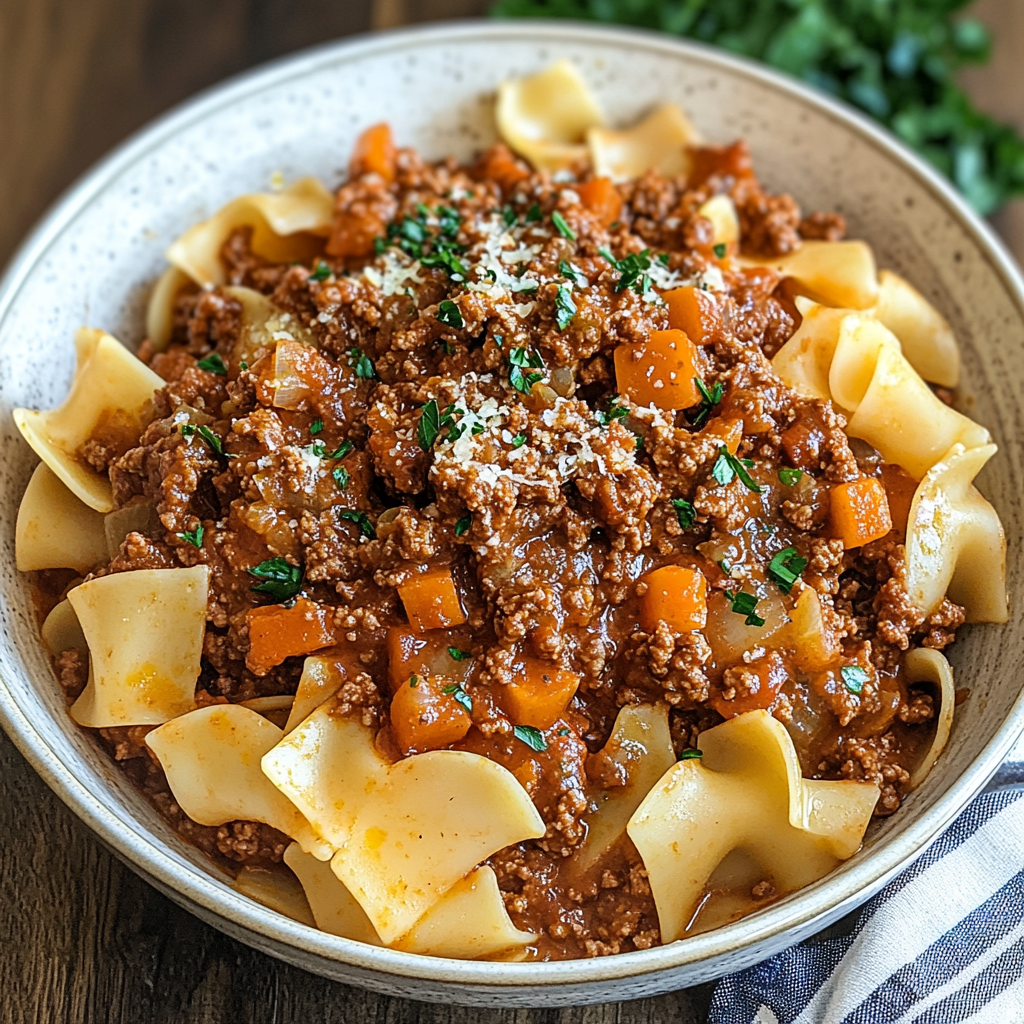The aroma of this slow-simmered beef bolognese will transport you straight to a cozy Italian kitchen. With a medley of aromatic vegetables, rich tomato flavor, and tender ground beef, this sauce is a soul-warming classic that brings people together.
Whether you serve it over spaghetti, tagliatelle, or your favorite gluten-free option, this dish is an irresistible dinner staple that’s perfect for family meals, casual gatherings, or an elegant date night in. Simple ingredients, patiently simmered – that’s the secret to truly unforgettable flavor.
Full Recipe
Ingredients:
-
2 tablespoons olive oil
-
1 large onion, finely chopped
-
2 carrots, diced
-
2 celery stalks, diced
-
4 garlic cloves, minced
-
1 ½ lbs ground beef (80/20)
-
1 tablespoon tomato paste
-
1 cup whole milk
-
1 cup dry white wine
-
1 can (28 oz) crushed tomatoes
-
1 teaspoon dried oregano
-
1 teaspoon dried basil
-
1 bay leaf
-
Salt and black pepper to taste
-
Fresh parsley, chopped (for garnish)
-
Freshly grated Parmesan (for serving)
-
1 lb spaghetti or pasta of choice
Directions:
-
Heat olive oil in a large, heavy-bottomed pot over medium heat. Add onion, carrots, and celery. Sauté for about 8 minutes until softened.
-
Stir in garlic and cook for another minute.
-
Add the ground beef. Cook until browned, breaking it apart with a spoon.
-
Mix in tomato paste and stir well to combine.
-
Pour in the milk, stir, and let it simmer gently until mostly absorbed.
-
Add white wine and allow it to reduce by half.
-
Stir in the crushed tomatoes, oregano, basil, bay leaf, salt, and pepper.
-
Bring to a gentle simmer. Reduce heat to low and cook uncovered for at least 1.5 to 2 hours, stirring occasionally.
-
Cook pasta according to package instructions. Drain and toss with the sauce or serve the sauce over pasta.
-
Garnish with parsley and Parmesan. Serve hot.
Prep Time: 15 minutes | Cooking Time: 2 hours | Total Time: 2 hours 15 minutes
Kcal: 475 kcal | Servings: 6 servings
The History and Origin of Beef Bolognese
Beef Bolognese, known as Ragù alla Bolognese in Italian, originates from Bologna, a city in the Emilia-Romagna region of northern Italy. Unlike the quick meat sauces often found in commercial spaghetti dishes, traditional Bolognese is a slow-cooked, deeply flavorful sauce that reflects Italy’s passion for using simple ingredients to produce extraordinary results. The recipe traces back to the 18th century, when it was first recorded by Pellegrino Artusi in his 1891 cookbook, La Scienza in Cucina e l’Arte di Mangiar Bene (“The Science of Cooking and the Art of Eating Well”).
Originally, Bolognese was intended to be served with tagliatelle—a flat, ribbon-like pasta that clings well to the thick sauce—rather than spaghetti, which is more common outside of Italy. Over the years, the dish has been lovingly adapted across the world while still maintaining the rich, meaty essence that defines it.
What Makes Bolognese Unique
What sets Beef Bolognese apart from other meat sauces is its depth of flavor, which is achieved through a specific balance of ingredients and a long, slow cooking process. The holy trinity of Italian cooking—onion, carrot, and celery—forms the flavor base. High-quality ground beef adds richness, while milk is a surprising yet traditional ingredient that tenderizes the meat and brings a subtle creaminess to the sauce. Dry white wine and crushed tomatoes deepen the flavor further, and herbs like oregano, basil, and bay leaf add complexity without overpowering the beef.
A key component of traditional Bolognese is patience. Unlike quick-cook pasta sauces, this one benefits from simmering for at least one and a half to two hours. This slow simmering allows all the elements to meld together into a robust, silky sauce that clings beautifully to pasta.
Tips for the Perfect Bolognese Sauce
To make a truly authentic Bolognese, it’s essential to focus on the quality of the ingredients and technique. Here are some expert tips:
-
Choose the Right Meat: Use ground beef with a good fat content (around 80/20) for richness. A mix of beef and pork can also elevate the flavor.
-
Layer Flavors Slowly: Sauté the aromatics until fully softened before adding the meat. Cook the meat thoroughly before adding liquids to build flavor.
-
Don’t Skip the Milk: Milk may seem unusual in a tomato-based sauce, but it mellows the acidity of the tomatoes and adds depth.
-
Cook Low and Slow: Simmer the sauce uncovered on low heat to allow evaporation and concentration of flavors.
-
Avoid Overstirring: Stir occasionally, but let the sauce rest between stirs so it thickens naturally and the flavors settle.
Serving Suggestions
While spaghetti is often the go-to pasta choice in many households, tagliatelle or pappardelle is more traditional and recommended for Bolognese. These wide, flat noodles hold the sauce well, ensuring a balanced bite every time. If you prefer a low-carb or gluten-free option, consider serving the Bolognese over spiralized zucchini, spaghetti squash, or gluten-free pasta.
This sauce also pairs wonderfully with polenta, gnocchi, or even as a filling in lasagna. Topping the dish with freshly grated Parmigiano-Reggiano and a sprinkle of fresh parsley takes it to the next level.
Variations and Modern Twists
Although purists may frown upon altering traditional Bolognese, many modern cooks adapt the recipe to suit different tastes and dietary needs:
-
Turkey or Chicken Bolognese: Substitute ground beef with leaner ground poultry for a lighter dish.
-
Vegetarian Bolognese: Use lentils or plant-based meat alternatives along with the traditional soffritto (onion, carrot, and celery).
-
Spicy Bolognese: Add crushed red pepper or a pinch of cayenne to bring heat.
-
Creamy Bolognese: Stir in a splash of heavy cream at the end of cooking for added richness.
-
Wine-Free Version: Substitute broth or even a splash of balsamic vinegar if avoiding alcohol.
These variations allow home cooks to personalize the sauce while still enjoying the hearty, comforting essence of the original.
Pairing Ideas
Beef Bolognese is a rich, savory dish, and choosing the right beverage can elevate the entire dining experience. Classic Italian red wines like Chianti, Sangiovese, or Barbera make perfect pairings thanks to their acidity and bold character, which cut through the richness of the sauce. If you prefer white wine, go for a dry white like Pinot Grigio or an oaked Chardonnay.
When it comes to side dishes, keep things simple and rustic. A green salad with a light vinaigrette, warm crusty bread, or roasted vegetables make excellent accompaniments. And of course, don’t forget dessert—something light like panna cotta or gelato balances the meal beautifully.
Cultural Significance
Bolognese is more than just a meat sauce; it’s a symbol of Italian heritage and culinary philosophy. It represents the importance of taking time with your food, honoring tradition, and using humble ingredients to create something memorable. In Italy, meals are about connection—about gathering around the table, savoring every bite, and sharing moments. Beef Bolognese captures that spirit perfectly.
Whether it’s a Sunday family dinner, a romantic meal at home, or a weeknight indulgence, Bolognese brings warmth and satisfaction to any occasion. It has traveled from Bologna to tables across the world, evolving with each kitchen while still preserving its original soul.
Conclusion
Beef Bolognese is a timeless, heartwarming dish that bridges cultures and generations. Its savory complexity, drawn from slow cooking and careful ingredient layering, makes it a staple in many kitchens. While variations abound, the soul of Bolognese remains the same: a deep, rich sauce meant to be shared with love.
By learning its history, respecting its roots, and perfecting your technique, you can bring a little piece of Italy into your home. Whether you’re a seasoned cook or just starting out, Beef Bolognese is the kind of recipe that invites you to slow down, taste deeply, and savor the joy of cooking.






